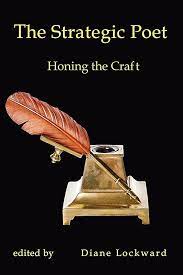by Miriam Calleja

Finding the right workshop host for your writing is unlike finding a favorite hairdresser or therapist. Yes, there are some that you will like much more than others. Some will seem to be on your frequency, feeding you what your writing needs at the time. There will be things about these individuals that resonate; perhaps not just their ideas or the way they get to the prompts, but also a cadence, a rhythm, and a tone of voice that is particular to them. That doesn’t mean you should stick to one mentor for the rest of your writing life.
There’s one uniting thread: Lockward’s belief that the best teacher of craft is a good poem. Ernest Hemingway said, “We are all apprentices in a craft where no one ever becomes a master.” One of the biggest frustrations is also one of the intense joys of writing and creativity. Simply, there is no end to it, no bottom to a cup that can keep giving… as long as we are willing to work on it.
Lockward’s books are aimed at those already familiar with poetry. That is, writers who will be familiar with specific jargon (or competent enough to look up the meanings when they aren’t) and, more importantly, who will be able to follow prompts and hold thoughts about a particular poem to produce writing of their own.
I would say that Lockward is being quite cautious in presenting her book in this manner. Every chapter presents ideas so clearly that even those dabbling in poetry will not find it hard to follow. The process is rendered transparent, like going backstage, watching professional actors remove their make-up, step into and out of characters. The book also progresses from the more accessible concepts to more complex ones, so the reader who feels they need to catch up might tackle the book in stages.
And so, once any perceived elitism melts away, and the writing process is made somewhat more accessible even as its complexity and layers are revealed, the reader discovers or rediscovers joyful richness. And herein lies the essence of this book – the voice of many is stronger than the voice of one.
Craft is taught like woodwork, architecture, or surgery. In other words – we study, observe, discuss, and see it from different angles, then take an angle and focus on it. We watch the masters do it, and then we imitate but make it our own.
Creativity is thus honed through the curation of lessons on tools. What do we have in our toolbelt already? What do others have? What do they do with these nifty tricks? How do they work with text, textures, and tempo to create poetry that makes a reader think, feel, and want to write? How do they bring so much to so few words?
The Strategic Poet: Honing the Craft takes the fly-on-the-wall approach as it shows us examples from each chapter’s workshop. In each chapter, we read a poem that reflects a brilliant use of the topic of the craft essay.
Let’s take a closer look. In Chapter XI, the focus is Syntax. The craft essay by Marilyn L. Taylor, “Craft Talk: The Elusive Art of the Link Break,” invites us to think about the differences in syntax between prose and poetry as “…assembly lines of words, ready to arrange and rearrange until you’ve turned your next poem into a nuanced gift…”
The poem “Abandoned Shacks in North Carolina” by Rob Shapiro, selected as the model poem following this discussion, exhibits line breaks that qualify our freshly learned or revised knowledge, demonstrating an emergence of meaning and pace through expert enjambment.
With the model poem on our minds, an explanation written by the poem elucidates the strategies used and helps us appreciate the workings and skill that went into its crafting.
At this point, we also meet our first writing prompt for the chapter, a suggestion that is not prescriptive but guides us to our creation, using the model poem as a springboard. Afterwards, to prove that the prompts have been tested in real life, we are presented with samples from writers who have come to their poems with this very prompt. It is as though fellow workshop attendees are sharing their work, perhaps after polishing it.
The poem-prompt-sample formula is repeated 3 times until the chapter ends with three more bonus prompts. With six prompts per chapter and thirteen chapters each on a specific poetic strategy, that’s quite a journey for a poet’s creativity. A must-have for libraries, poetry teachers, and workshop leaders; an excellent library addition for any poet.
Miriam Calleja gives herself and others permission to write. She is the Maltese bilingual author of poetry collections Pomegranate Heart, Inside, Stranger Intimacy, the chapbooks Remember and The joy of the unknown fictitious monster, and the collaboration Luftmeer. Her work has appeared in Odyssey, Whale Road Review, The Compulsive Reader, Tupelo Quarterly and elsewhere. Her translated work has appeared in the performance Medinea, on Red Fern Review, and is forthcoming in Modern Poetry in Translation, Taos, and platform review. Over the past year she has been published in Incontri Incrociate 2 (with Italian translation), Cross Currents (with Romanian translation), Xtaqt li Kont Merkurju (Inizjamed, 2022), and Awarded Writers Collection 2022 (first place in the freestyle poem category).



An excellent review, showing what the book has to offer without miring in minutiae.